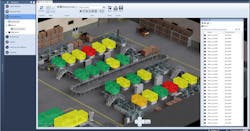MES Upgrades from Werum IT Solutions and Critical Manufacturing
Like most software suites, the breadth and depth of what a manufacturing execution system (MES) will do expand with each new release. Early versions of commercial MES software behaved as autonomous systems dedicated solely to monitoring work-in-progress on the factory floor. While improving overall productivity and reducing cycle times was—and still is-- the goal, the MES systems of today are multi-tasking managers of enterprise schedules, material tracking, electronic batch records (EBR), overall equipment effectiveness (OEE), and manufacturing intelligence.
The scalability and versatility of the modern MES can be a tremendous benefit to manufacturers with large global operations and small production windows. For the system operators, however, the more features and functions that clutter up the computer screen, the more MES can turn into a mess.
Recognizing the need to streamline the way users interact with the system, vendors are focusing on the front end interface, adding functions that ease software operability. In January, Werum IT Solutions and Critical Manufacturing rolled out upgrades to their MES systems for the pharmaceutical and high-tech industries respectively.
Werum’s PAS-X v3.1.7 for the pharmaceutical and biopharmaceutical industries includes new user guidance dialogs for electronic batch recording, the company says.
Based on feedback from end users, Werum optimized certain automatic processes to improve overall user experience. For example, operating elements are placed in on-screen positions and in different font sizes to provide easy recognition of order status or the current execution step. In addition, a new KPI operator dashboard provides real-time data on OEE, quality, production rates, and more, through color-coded graphical representations.
The effort to move MES to an intuitive graphical user interface mirrors what is currently happening with distributed control systems (DCS), which are designed to put as much digital data in front of the operator as possible. The purpose is to provide a view of everything happening on the factory floor; the problem is that it can be overwhelming for the user and do more harm than good. Industry observers say most industrial accidents are a result of human error, especially when it is difficult to assess the deluge of data displayed on the human machine interface (HMI). As a result, DCS vendors are adopting next-generation HMIs that present information in a manner that humans can absorb quickly—which is similar to what Werum is doing with its PAS-X MES.
Separately, Critical Manufacturing rolled out cmNavigo 4.0, a Microsoft-based operations management system for semiconductor, electronics, and medical device industries. The new version now has finite scheduling embedded into the MES. This functionality models plant floor resources and define the role of each in fulfilling a mix of orders in an optimal near-term time frame. Schedules can be weighted around multiple production criteria and KPIs, such as minimizing delivery delays, maximizing machine loads, and reducing cycle times.
While most MES systems can support finite capacity scheduling, it is often through a third-party system, which runs the risk of problems such as duplication of master data and the need to use and maintain separate interfaces, the company says.
Now, as a native capability to cmNavigo, the scheduling application integrates with 30 other applications, including five new functions delivered as part of the upgrade.
Other cmNavigo capabilities include: Lot-based sampling (enables automated calendar or time-based sampling of production); Document management (provides visualization, control, and approval of shop floor operations-related documents); Warehouse management (synchronizes the exchange of information and material between the warehouse and the plant floor); Durables-tracking (simplifies tracking of boards, fixtures, tooling, and masks, supporting recipe management, maintenance, exception handling, and data collection); And, shift logbook (regulating the exchange of critical information between shifts).
While approaching the interface issue in a different way than Werum, Critical Manufacturing is also trying to solve the problem of making it easier for an operator to interact with the MES.
“As margins in global high-technology manufacturing shrink, many manufacturers are finding that their legacy MES systems don’t have the flexibility and functionality to meet the demands of today’s volatile markets, “ say Francisco Almada-Lobo, CEO of Critical Manufacturing. “The new scheduling, quality control, warehouse management, and shift handoff capabilities reflect our commitment to provide the most modern and unified MES solution available.”
About the Author
Stephanie Neil
Editor-in-Chief, OEM Magazine

Leaders relevant to this article:
